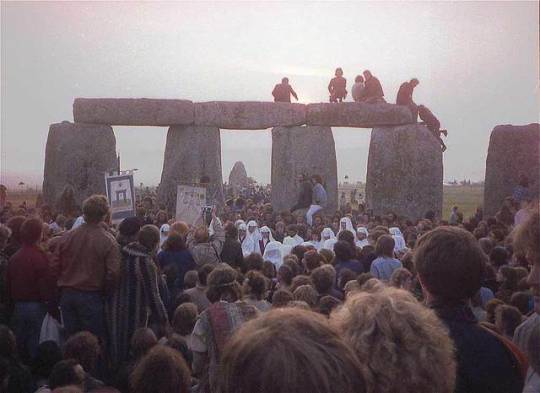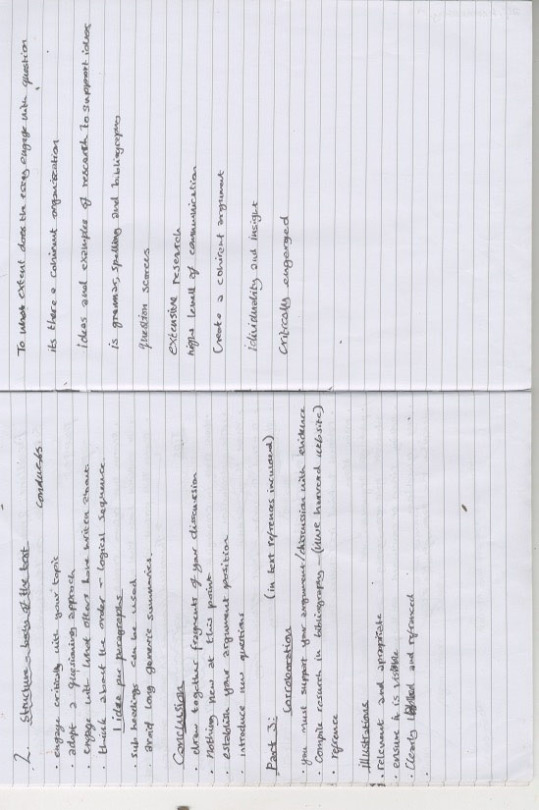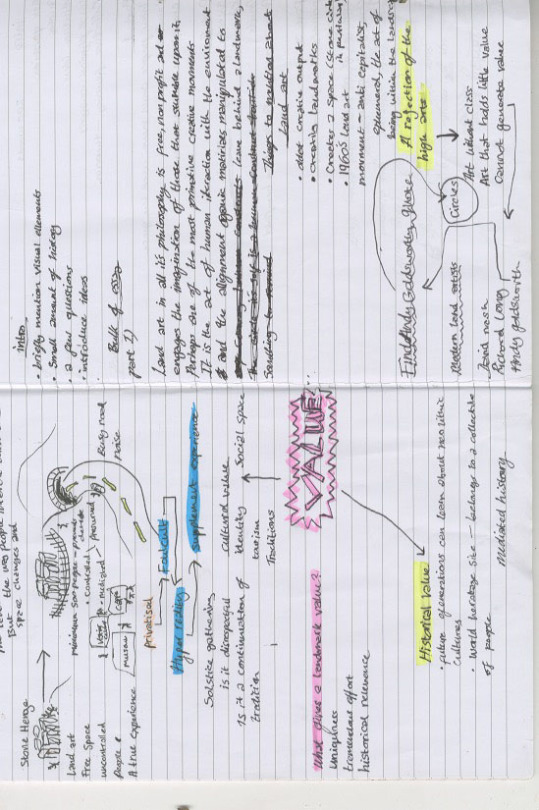Text
The purpose of Stonehenge is a debatable mystery, some say it is a calendar, others a burial ground; while some engage in the possibility of aliens, fairies and conspiracy.
It is the unknown and the mysterious that encourages this collective fantasy and draws people from all over the world to Stonehenge.
For thousands year’s people have been able act freely within this space, and fully involve themselves in a true firsthand experience in an unmediated fashion.
1974 to 1984 Stonehenge became the venue of the annual Stonehenge free festival, which took place on the solstice as a continuation of pagan Neolithic British tradition as well as being at the forefront of the free festival movement.
Allowing for the engagement of people within an atmosphere of creative collaboration, music, art and ritual practices from both druid community, the new age traveler movement, as well as locals and tourists alike.
The event attracted tens of thousands of people each year, causing much concern and extensive debate in regards to the preservation of both the surrounding environment and the monument its self.
In 1984 the department of environment handed the monument over to English Heritage.
The following year the Stonehenge free festival was prevented from happening by police from six surrounding counties and the ministry of defense of whom inflicted their will through the application of brute physical force.
An act of police brutality very similar to that of the miners strikes the year before.
Witnesses speak of nonnegotiable physical violence, caravans/living vehicle’s being smashed and people being prevented from leaving the bean field that they had been forced into by police road blocks either side of the A303 in Wiltshire, making it impossible for anyone to move towards or even away from Stonehenge.
‘The battle of the bean field’ was used by the media to generate hysteria against the travelers, gypsies, and protesters paving the way for the 1986 public order act to which allows for the forceful eviction of two or more people under the grounds of unlawful trespass, this attack on civil liberties continued with the events of castle Morton common free festival which lead to the 1994 criminal justice act which replaced the 1968 caravan sites act resulting in the marginalization and criminalization of the entire gypsy and traveler culture.
(Andy Warrington, guardian)
Fencing was set up in 1978 to decrease the impact of tourism.
Museums, coffee shops and an entrance fee soon followed.
Turning what once was a free open space into an object of a high arts to which people must pay to go and see but not fully experience.
According to a study conducted by peter mason and I –Ling during the late summer and early autumn of 2003, 50% of people visiting Stonehenge did not make it past the visitors entrance but instead indulged themselves in the consumption of coffee and gifts from the shops or simply looked at the monument from the road and car park as to avoid the admission fee.
Foucault’s ideas of a hyper reality seems somewhat relevant within this transition of conduct.
‘Becoming a theme park of your own history, long since ceased to be authentic’; ‘we are giving you the reproduction so that there is no need for the original’ (the nature of capital, Marx after Foucault).
This privatization of Stonehenge speaks a lot in regards to our current state of our culture and the way in which we conduct ourselves and interact within a place.
‘The common responsibility to safeguard for future generations is recognized.
It is our duty to hand them on in the full richness of their authenticity’ (UNESCO – 1COMOS 1964)
It is the responsibility of the individual to act with consideration so the collective can benefit.
Unfortunately not everybody thinks in this manner.
People would take fragments of the stones as a souvenir, leave rubbish and act disrespectfully within the space yet many of the people visiting Stonehenge did not act in this way, yet their experience has become limited by the actions of the few.
But what is authenticity, what makes one object more valuable than another in terms of historical relevance, who decides what is important and how meanings in an object can contribute to the narrative that is human history?
‘Notions of heritage and authenticity seem to imply there is a deep rooted need for objects and places to be endowed with value, even if that value is entirely a scocio-phyco-cultural invention that is that objects and places have no intrinsic wroth other than the invisible quality, which a culture chooses to project upon it’ (David Littlefield).
Our current perception of time is linear, archeologists look at history from an asymmetrical standpoint. The past is in the ground awaiting to be unearthed and the facts will be found through the art of reductionism, however David Littlefield’s ideas of symmetrical archeology considers the archeologist as an active creator of narrative and meaning, all of which is culturally determined.
‘The past and present hold a somewhat uneasy balance’ and therefore must find a way to coexist (David Littlefield).
By restricting access to Stonehenge and mediating the way in which people act there we are suspending a moment in time In order to preserve it, and keep it authentic, but by doing this we are preventing the present from interacting with the past.
‘An objects presence in time and space, its unique existence of the work of art determined the history to which it was subject throughout the time of its existence. This includes changes it may have suffered in physical condition over the years as well as the various changes in ownership.’- (Benjamin Walter, 1935)
Perhaps the way people interact with Stonehenge is part of its history and by allowing a collaboration of past and present a new and exciting future can be created.
‘Negotiate a way through elusive notions of heritage and authenticity by appropriating the past as raw material for creative endeavors.’ (David Littlefield)
Bibliography
Jiven, Julia and Peter J Larkham. Sense Of Place, Authenticity And Character: A Commentary. 1st ed. Carfax Publishing, 2003. Web. 9 Mar. 2017.
Kuo, I-Ling and Peter Mason. Managing Megalithic Monuments: A Comparative Study Of Interpretation Provision At Stonehenge And Avebury. 1st ed. United Kingdom: Goodfellow Publishers Limited, 2017. Web. 8 Mar. 2017.
Leask, Anna. Managing World Heritage Sites. 1st ed. [Place of publication not identified]: Routledge, 2016. Print.
Littlefield, David. Heritage At The Periphery, The York Street Vaults, The Roman Baths, Bath. 1st ed. Bath: University of West England, 2012. Web. 8 Mar. 2017.
Springfield, Herbert. The Ceremony At The Stones. Avebury: http://www.ukrockfestivals.com/henge-history-84.html, 1984. Print.
Marsden, Richard. The Nature Of Capital: Marx After Foucault. 1st ed. London and New York: Routledge, 1999. Print.
'The Work Of Art In The Age Of Its Technological Reproducibility. 2nd ed. New York: Schocken Books, 1936. Web. 7 Mar. 2017.
Walter, Benjamin. The Work Of Art In The Age Of Mechanical Reproduction. 1st ed. New York: Schocken Books, 1936. Web. 11 Mar. 2017.
Warrington, Andy. "Remembering the Battle Of The Benfield". Guardian 2009: 4. Web. 9 Mar. 2017.
0 notes
Text
Bell Hooks
When reading Bell Hooks 2010 ‘teaching critical thinking; practical wisdom’ I can acknowledge that for an academic text it does not hold much substance in the terms of factual data and statistics.
It is intact very personal and regards her own individual experience, as both a student and a teacher within a racially segregated society.
In the text she gives us a back story of what it was like for at school and the way in which her tutors would educate ad encourage independent thinking as well as teaching a strong sense freedom and to speak out against social injustice.
Upon entering college Hook had a very different experience, no longer being in an all-black institution she had to deal with racial tension and bullying from both lecturers and students as well as finding the lessons less encouraging.
Hook expresses a lot of points regarding the indoctrination of children entering mainstream education, and how learning for many has become all about regurgitating stale information for the purpose of ticking a box.
One of them being that children are all critical thinkers but that ability degrades as the child gets older.
I found this very interesting yet the text could not factually reinforce this idea and the only thing we are given in the text is bell hooks own personal opinion and experience.
I then went away and researched this theory and found evidence of an experiment that was carried out where 15,000 students were tested on their ability to think critically and divergently.
98% of younger students in their first year of education scored a genius level on the test.
This test was then repeated with the same students at different age brackets through their education and the number of people who obtained a genius level decreased each year.
Only one variable was changed during that test and it was age thus concluding bell hooks theory to be correct.
All in all the text is not full of facts and does not compose its self of complicated words and terminology but this in its self, shows her awareness of teaching and learning on an equal level and while most of it is opinion based I feel it is a very well informed opinion.
0 notes







